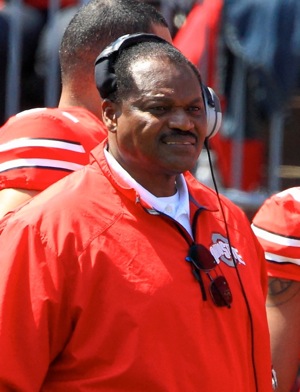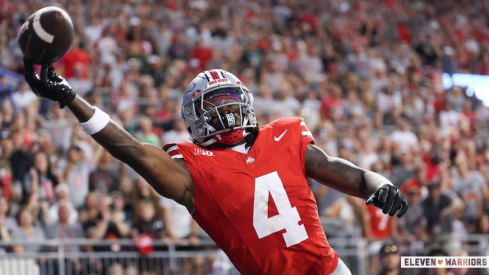To rotate or not to rotate, that is the question.
When Mike Vrabel coached the defensive line in 2012 and 2013, his aversion to rotating defensive linemen was well documented. Vrabel wanted his best players on the field at all times, an approach considered more pro-style than college. After two highly successful seasons, Vrabel now finds himself on the coaching staff of the Houston Texans.
Enter Larry Johnson, longtime Penn State defensive line coach. Johnson has a track record for getting guys to the pros, but with a very different style from Vrabel. In particular, the angle that has been played up since Johnson’s arrival is his willingness to rotate a larger group of linemen. Buckeye linemen will be utterly dominant in the fourth quarter because they will be rested – or so the theory goes. To be honest, I’m skeptical that rotation will lead to a massive improvement.

If NFL defensive linemen can play the entire game, why can’t college defensive linemen? NFL players play football and train for a living, but college players – especially at a schools with phenomenal strength and conditioning programs like Ohio State – are in rigorous training throughout the year. Sure, pro players are older and more physically advanced than college players; does that mean college players can only handle half as many snaps? It seems like a stretch.
What's more, the talent gap between first and second strings is greater in college than the NFL. Vince Wilfork at 50% is worse than his backup; Jadeveon Clowney at 50% is better than anyone South Carolina could put in for him, and a tired Noah Spence could probably outperform his backup as well. On the whole, I'd rather have Bosa, Bennett, Washington and Spence on the field at all times.
Still, this is a topic that deserves an objective look before jumping to any conclusions. What we’re going to do today is expand on what we’ve learned with offensive and defensive line analytics to determine if fatigue limited the defensive line’s effectiveness last fall, and what impact a larger rotation could have this year.
RELATED: GBR Primer and Defensive GBR
A few weeks back, I explained Good Blocking Rate (GBR) as a measurement of an offensive line's success against a defensive line. After that, I applied GBR to the defensive line and brought in a new stat called Sack + Hurry Percentage (S+H%) that measured the Buckeyes' ability to pressure the quarterback. After running the numbers, it was determined that last year's defensive line was very good, though not quite elite.
Towards the end of that piece I briefly mentioned what I found regarding Ohio State's quarter-by-quarter splits:
| rush attempts | well blocked | oGBR | |
|---|---|---|---|
| 1st-3rd Quarters | 321 | 202 | 62.9% |
| 4th Quarter | 101 | 58 | 57.4% |
If the Buckeyes' front four were fatigued in the fourth quarter, they didn't show it. They were substantially better in the fourth quarter against the run than they were in the first three quarters, but why?
One possible explanation is strength and conditioning coach Mickey Marotti's fitness regimen. He has a reputation for excellence, and he may have conditioned the defensive line well enough that opposing offensive lines wore down first. If this is the case, it would support leaving the starters in.
Nevertheless, there could be an explanation that supports rotating more often. In 2013, Ohio State often had the game in hand by the fourth quarter and brought in backups, who did a better job than the tired starters. To test this hypothesis, I broke down the above splits even further - into close games (winning by 10 or less, or losing) and blowouts.
| rush attempts | well blocked | oGBR | |
|---|---|---|---|
| 1st-3rd Quarters | 143 | 96 | 67.1% |
| 4th Quarter | 42 | 24 | 57.1% |
| rush attempts | well blocked | oGBR | |
|---|---|---|---|
| 1st-3rd Quarters | 172 | 110 | 64.0% |
| 4th Quarter | 59 | 32 | 54.2% |
In both close games and blowouts, opposing offenses were 10% less successful in the fourth quarter than the rest of the game. No matter how you slice it up there isn't any evidence that the the line performed worse when starters had to play the whole game.
In fairness this is a pretty small sample size, and the defensive line might be better this fall while rotating more often. Other rotation factors, like having a deeper group that's able to handle injuries, can't easily be quantified but are important as well. I'm looking forward to tracking this in the fall to see how much of an impact a deeper rotation has.

